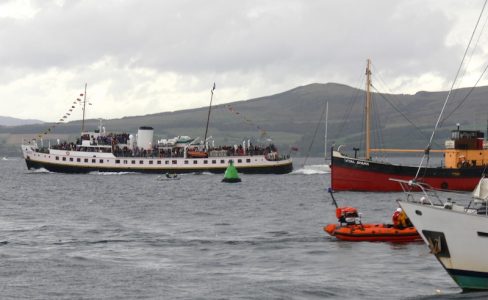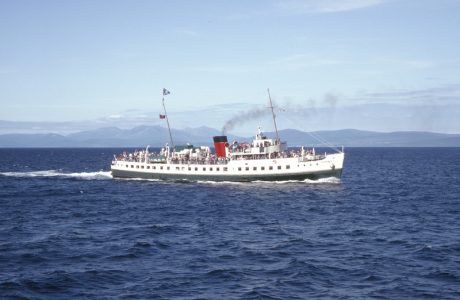
Balmoral passes Queen Elizabeth 2 at Greenock’s Ocean Terminal on 20 September 2007. Copyright Hamish Bowie
As Balmoral prepares for her September weekend on the Clyde, Walter Bowie recalls his happy association with the ship.
In late August 1999, I received a phone call during which I was asked an unexpected question: “How quickly can you get to Penarth?” The caller was Captain Graeme Gellatly, who earlier that summer had lured me back to pursering — the job I had done on more than 20 different steamers and ferries in the Clyde and Western Isles from the 1960s to the 1980s.
My initial reaction was “where exactly is Penarth?” Some weeks previously, Captain Gellatly had asked if I’d like to help with Waverley, an offer I was more than delighted to accept, and at the end of the Clyde season he said he’d send for me when the steamer started to get busy on the South Coast. So when I heard him on the phone, my assumption was that he was somewhere near Southampton or Bournemouth. He then told me it was not for Waverley that I was being asked to go, but to Balmoral (at that time still operated by Waverley Excursions Ltd), and that Penarth was near Cardiff. The ship’s long-time Purser had left suddenly, and Captain Gellatly had suggested they send for me to be Purser for the remainder of the season.

As Para Handy himself might have said “Isn’t that picture of a well laden Balmoral and Vital Spark not chust sublime?” It dates from 20 September 2007. Copyright Hamish Bowie
I managed to ‘get up and go’ the very next day. I knew I had to be on board by a certain time, but didn’t understand the full urgency of this until I got there and discovered the huge tidal range on the Bristol Channel — more than twice that of the Clyde. This has a big impact on when a ship can and can’t berth. Some of the piers almost dry out at low water. On the day I joined Balmoral, for example, she had to vacate the berth at Penarth before the water got too low. On other occasions we had to wait off a pier for a wee while until the tide rose sufficiently for us to come alongside. The area around Avonmouth, one of the few overnight ports used by Balmoral, has the second highest tidal range of anywhere in the world (the highest being in Canada).
This was not only my first time on Balmoral but also my first experience of sailing on international voyages — between England and Wales! I soon got used to being on what I had previously thought of as ‘Waverley’s other boat’. I enjoyed sailing on what they call ‘The Channel’, and being able to visit such lovely places as Ilfracombe. One thing I found rather strange was that, unlike on the Clyde, the ship spent most nights at anchor, making it difficult for me to sample the joys of ‘foreign’ (to me) ports. However, it gave the crew the chance to mix and socialise, and everyone on board certainly did that. It is good to see that Balmoral’s reputation for being ‘a happy ship’ continues to this day.
After a few weeks away from home territory, I came back to the Clyde with Balmoral for her autumn visit, which included the annual Millport Illuminations cruise. I found this a particularly pleasant experience — almost ‘reliving my youth’ as they say, for I had been Assistant Purser on the paddler steamer Caledonia each year from 1965 to 1969, and also on Queen Mary II for her visit to the Illuminations on 26 September 1970.

Captain Steve Michel (right) on the bridge of Balmoral during an earlier encounter with Queen Elizabeth 2 on the Firth of Forth. Copyright CRSC Dr Joe McKendrick Collection
I was the last Purser to serve on Balmoral in 1999, which meant I sold the last ticket of the century — to a member of CRSC! I was offered the job again in 2000 but didn’t want to be away from home for such long times, as my mother was in her 90s and I needed to be at hand. However, I was asked if I would be willing to serve as Relief Purser on both the paddler and the motor ship, and this I enjoyed doing each season until 2004.
I have some lovely memories of my days on Balmoral. When I first set foot on her, I was greeted by a Master I had never previously known. This was Captain Edward Davies (father of Luke Davies, a former Master of Waverley). Ted had a long association with Balmoral, having worked on her in ‘the Campbell days’ of old. I really enjoyed sailing under him: he educated me about many aspects of the Bristol Channel area, in which he showed great pride. Over the years I sailed on Balmoral with several other Captains and, like Ted, they were all good ship handlers.
Our main departure points were Penarth on the Welsh side and Clevedon on the English, and we called at a variety of interesting piers such as Weston-super-Mare, Lydney and Minehead. But the most fascinating sail was up the River Avon. This involved negotiating the Avon Gorge and the infamous Horseshoe Bend, where several ships have had mishaps over the years, and then passing under the famous Clifton Suspension Bridge on the way to Bristol docks. Incidentally, the engine room alleyway on Balmoral always reminded me of the last two Clyde ‘Duchesses’.
While she is a good sea-boat, I always had the feeling she could roll in the proverbial wet grass. When the Maritime and Coastguard Agency decided that passengers had to be registered for certain longer journeys, I was involved in compiling these registrations for Balmoral’s sailings from Barrow-in-Furness, Whitehaven and Garlieston to the Isle of Man. We had some lively sailings across the Irish Sea.

Better in red? Balmoral in Walter Bowie’s preferred livery. Copyright CRSC Dr Joe McKendrick Collection
Thanks to Balmoral, I have some unusual ports in my Discharge Book, such as Dundee. After signing on there on 31 May 2001, I had the unique pleasure of sailing right up the Tay on Balmoral and berthing in Perth Harbour. During that spell, before signing off at Leith on 4 June 2001, we cruised to the Bass Rock. I am also one of only two people to have signed off at Tarbert, Loch Fyne. That was on 25 September 2001, when Balmoral made an unusual visit there for a BBC charter which I was instrumental in arranging for WEL. The BBC wanted the bridge painted brown to resemble an old David MacBrayne steamer, and likewise the funnel was painted red with black top. To be honest I always thought Balmoral looked best with a red-and-black funnel rather than the bland Campbell white without a black top.
On the light sail down-firth to Tarbert, I asked one of the BBC men why they wanted the funnel the way they had it — with a thin white band. The reason, I was told, was to make her look as far as possible like an old West Highland steamer. I told the man that they didn’t have a white band between the red and black. He took some persuading before he realised I knew a wee bit about the Scottish ferries of old as well as the present. As a result, they arranged that, for the side of the ship next to Tarbert pier (only one side being seen in the film), a long piece of black tape was stuck over the white band! The Master on that occasion, resembling one of the old MacBrayne skippers, was Captain Stephen Colledge.
I was invited out of retirement by CalMac’s management to give the commentaries on Queen Elizabeth 2’s last two visits to the Clyde. Balmoral was present on both occasions. The photo of the month (top of page) was taken by my brother Hamish on the first of these — Thursday 20 September 2007, when QE2 was on her 40th anniversary cruise. The second, taken by me from the bridge of Saturn (below), documents QE2’s final visit, on Sunday 5 October 2008. I think it perfectly sums up the atmosphere of the day.
It was a privilege and honour to be able to do the onboard commentary. One element of it that I secretly enjoyed was watching not only the great liner but also Balmoral, which was on an identical mission to Saturn. With so many people looking at the liner (or was it looking at us?) she seemed to be far from totally upright. In fact I could almost swear that one propeller was nearly in the air! But not quite. I remember with pleasure, in my ad lib commentary, telling our passengers about the countless small boats that had turned out for the day, and that “there is an English pleasure steamer which has come to the Clyde all the way from Bristol to see this event.”
QE2 may no longer be here, but I am delighted that Balmoral is returning for another late season visit, and that the tradition of a Millport Illuminations cruise is being upheld.
Balmoral’s September weekend sailings run from Thursday 21 to Monday 25 September inclusive, and include visits to Lochranza, Campbeltown, Tarbert and the Millport Illuminations.
https://www.whitefunnel.co.uk/

View from Saturn‘s bridge on 5 October 2008, with Balmoral on the right and Queen Elizabeth 2 berthed at Greenock on her final visit to native waters. Copyright Walter Bowie

Destination Isle of Man: Balmoral and Seacat Denmark on 22 May 1998 at Douglas, a port to which Balmoral seems unlikely to return in the foreseeable future. Copyright CRSC Dr Joe McKendrick Collection

Happy memories: Walter Bowie was Assistant Purser on Queen Mary II on 26 September 1970 for the Millport Illuminations Cruise, to be repeated by Balmoral on 23 September 2017 — this time at Keppel, not the Old Pier. The vessel on the right of the ‘Mary’ is Keppel. Copyright CRSC J.T.A. Brown Collection
Click here to join CRSC and share in the benefits — special publications, exclusive shipyard visits, organised cruises and winter talks by shipping experts.











